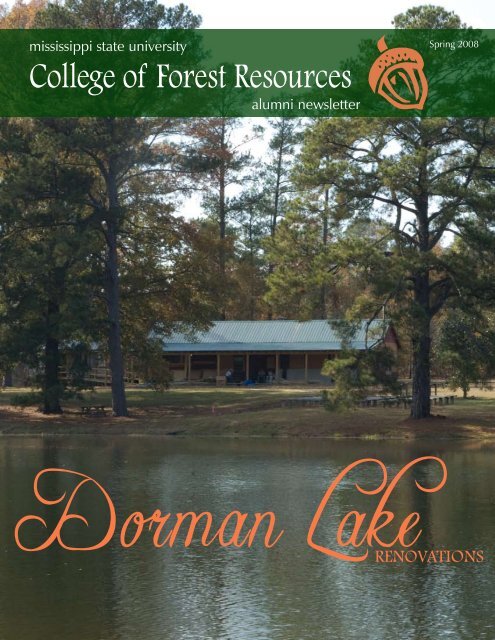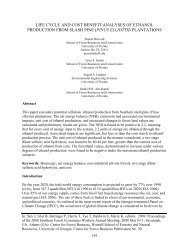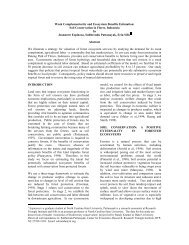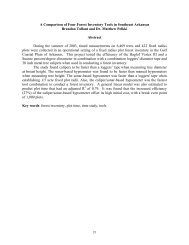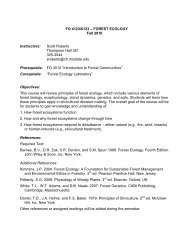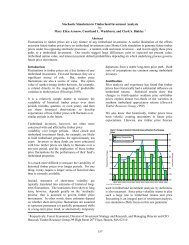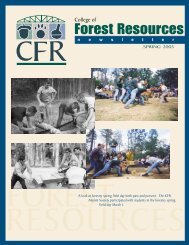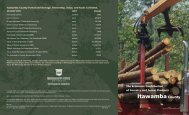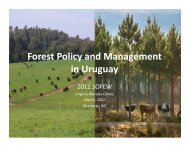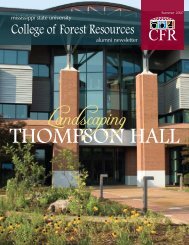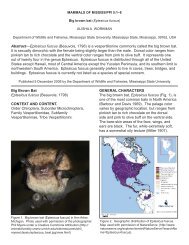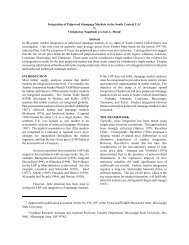Spring 2008 - College of Forest Resources - Mississippi State ...
Spring 2008 - College of Forest Resources - Mississippi State ...
Spring 2008 - College of Forest Resources - Mississippi State ...
Create successful ePaper yourself
Turn your PDF publications into a flip-book with our unique Google optimized e-Paper software.
mississippi state university<br />
<strong>College</strong> <strong>of</strong> <strong>Forest</strong> <strong>Resources</strong><br />
alumni newsletter<br />
<strong>Spring</strong> <strong>2008</strong><br />
Dorman Lake<br />
r e n o vat i o n s
2<br />
college <strong>of</strong> forest resources<br />
alumni newsletter<br />
dean’scomments<br />
This year is already looking great, with so many accomplishments for the college<br />
and university. The football team won a bowl game, the women’s s<strong>of</strong>tball team is<br />
ranked and the basketball team won the SEC West and is going to “dance” in the<br />
NCAA tournament. The <strong>Forest</strong> and Wildlife Research Center funding was restored to<br />
2001 levels. The forestry and forest products curricula were accredited for another 10<br />
years. The college saw an 11 percent increase in enrollment in fall 2007, which was<br />
the greatest percentage change on campus.<br />
The tide has turned for the <strong>College</strong> <strong>of</strong> <strong>Forest</strong> <strong>Resources</strong> and everything is looking great thanks, in large part,<br />
to the support and confidence provided by our strong alumni base. Your support is critical to our success.<br />
The faculty, staff and students continue to be committed in delivering as promised, addressing the needs <strong>of</strong><br />
the people and resources served. However, our work is not complete, and we need your continued help and<br />
support to accomplish our mission and vision.<br />
Speaking <strong>of</strong> vision, I want to share with you some exciting news. We recently completed a visioning process.<br />
A team <strong>of</strong> faculty and staff—the visioning task force—recently completed a vision statement for the college and<br />
center. The task force solicited input from everyone in the college. The result is a vision statement in which<br />
everyone has ownership. Please take a moment to read the vision statement on page 13. It clearly states who<br />
we are, what our priorities include, and values for those we serve.<br />
Also scholarships, endowments and properties are increasing for the college. Two new properties have been<br />
added to the Bulldog <strong>Forest</strong>, increasing the acreage by 500. One <strong>of</strong> the gifts was given by department head<br />
Bruce Leopold. Also, a new commercial is airing on the MSU baseball radio network for the Bulldog <strong>Forest</strong>.<br />
We are very hopeful this advertisement will generate increased interest in the program. New scholarships have<br />
been added to the college, however, we need additional resources to attract the best and brightest students. We<br />
are going to soon launch a scholarship campaign. As you know, tuition is increasing and many <strong>of</strong> the students<br />
cannot afford the rising costs. Please consider how you might help in generating needed funds for our students.<br />
Any size gift can help students discover their passions.<br />
We have been working on recruiting new students to the program. We hired a recruiter, Tedrick Ratcliff, a<br />
forestry alumnus and enthusiastic young man. If you know <strong>of</strong> a young person interested in natural resources,<br />
please contact Tedrick (tratcliff@cfr.msstate.edu). Don’t forget your own family members who may have an<br />
interest in following your footsteps. Remember the saying, “An acorn never falls far from the tree.”<br />
The Mid-South <strong>Forest</strong>ry Equipment Show is scheduled this year for June 6 and 7, <strong>2008</strong>. This show is the<br />
biggest in the region and is becoming one <strong>of</strong> the biggest equipment shows in the nation. Numerous continuing<br />
education opportunities are planned this year. We will host an alumni social on Friday night at the newly<br />
renovated Dorman Lake Cabin. Please attend the equipment show and the transformed cabin.<br />
We need your help this year during the spring legislative session. We are asking for a small increase this year<br />
for FWRC to maintain our growth. Last year’s funding provided graduate assistantships and helped with rising<br />
utility costs, salary increases and increased research support. Any assistance you can provide in Jackson will be<br />
appreciated.<br />
I am excited to announce that an extension program has been established in the department <strong>of</strong> forest<br />
products. This is great news for <strong>Mississippi</strong>, the forest products industry and homeowners.<br />
There is so much good news, please read the details in this newsletter. I hope to see you on campus or out<br />
in the state soon. We appreciate your support and welcome your participation in the future <strong>of</strong> the college.<br />
George M. Hopper<br />
Dean
2007 alumni Fellow<br />
John Hodges<br />
The <strong>College</strong> <strong>of</strong><br />
<strong>Forest</strong> <strong>Resources</strong><br />
2007 Alumni Fellow<br />
is John D. Hodges <strong>of</strong><br />
Ashland. A 1959<br />
forestry graduate,<br />
Hodges was one <strong>of</strong> the<br />
first students to earn<br />
a bachelor’s degree<br />
from the then-young School <strong>of</strong> <strong>Forest</strong>ry.<br />
Hodges holds master’s and doctoral degrees<br />
from the University <strong>of</strong> Washington. He<br />
joined the faculty in 1975 and taught<br />
silviculture and conducted research in the<br />
areas <strong>of</strong> hardwood silviculture, physiology,<br />
ecology, and wetland restoration until 1996.<br />
Hodges retired from <strong>Mississippi</strong> <strong>State</strong> and<br />
went to Anderson-Tully where he led the<br />
company’s land management program. In<br />
2000, Hodges returned to MSU to run the<br />
hardwood forestry extension program.<br />
<strong>2008</strong> alumnus<br />
<strong>of</strong> the Year<br />
Jim Tidwell<br />
James H. “Jim”<br />
Tidwell <strong>of</strong> Frankfort,<br />
Ky., is the <strong>2008</strong><br />
Alumnus <strong>of</strong> the Year for<br />
the <strong>College</strong> <strong>of</strong> <strong>Forest</strong><br />
<strong>Resources</strong>. A 1987<br />
doctoral graduate in<br />
aquaculture, wildlife<br />
and fisheries, he is aquaculture division chair at<br />
Kentucky <strong>State</strong> University’s Aquaculture Research<br />
Center. Tidwell received a bachelor’s degree<br />
from the University <strong>of</strong> Alabama at Birmingham,<br />
and a master’s from Samford University. As<br />
coordinator for aquaculture programs, Tidwell<br />
is responsible for oversight <strong>of</strong> all aquaculture<br />
programs (research, extension and education)<br />
at KSU. This includes coordination <strong>of</strong> schedules,<br />
allocation <strong>of</strong> physical resources, and maintenance<br />
and operations <strong>of</strong> the Aquaculture Research<br />
Center (ARC).<br />
Three <strong>College</strong> <strong>of</strong> <strong>Forest</strong> <strong>Resources</strong> faculty members were honored recently with<br />
outstanding achievement awards. Receiving the 2007 awards are (l-r) wildlife and<br />
fisheries pr<strong>of</strong>essor and interim associate dean Richard M. Kaminski for service,<br />
wildlife and fisheries pr<strong>of</strong>essor Craig Tucker for research, and forestry pr<strong>of</strong>essor<br />
Robert Parker for teaching.<br />
Accolades<br />
<strong>Mississippi</strong> <strong>State</strong> University <strong>College</strong> <strong>of</strong> <strong>Forest</strong> <strong>Resources</strong> animal care coordinator<br />
Steven Tucker (l) and building supervisor Curtis Griffin recently were honored<br />
with 2007 Doris Lee Memorial Staff Awards for outstanding service. Tucker, an<br />
MSU alumnus, cares for native wildlife at the Wildlife and Fisheries Research and<br />
Educational Facility, providing 3,000 educational tours annually. Griffin has been<br />
at the university for 29 years and oversees maintenance and upkeep for more than<br />
200,000 square feet <strong>of</strong> CFR space.<br />
spring <strong>2008</strong><br />
alumni newsletter 3
4<br />
Dorman Lake<br />
renovation<br />
college <strong>of</strong> forest resources<br />
alumni newsletter<br />
The forest facilities staff has completed the<br />
renovation <strong>of</strong> the Dorman Lake cabin. The newly<br />
renovated facility has seating for approximately 54<br />
during classroom style activities, and a dry erase board<br />
with projector screen is permanently installed on the<br />
wall.<br />
The kitchen facility has a freezer, a refrigerator, two<br />
gas stove/range oven combinations, a commercial dish<br />
washing sink, and a 55-pound ice maker.<br />
Thanks to a generous donation by the CFR alumni<br />
society, two five-ton air conditioning systems keep<br />
the cabin cool in the summer. The fireplace provides<br />
ample heat in the winter.<br />
A major portion <strong>of</strong> the renovation entailed the<br />
addition <strong>of</strong> a new bathroom facility attached to the<br />
lodge. A covered walkway joins the newly completed<br />
bathroom facility with the old lodge. Additionally, a<br />
12-by-four-foot cooking grill with cover also was built<br />
adjacent to the lodge. This should provide capacity<br />
for approximately 150 to 200 steaks to be grilled<br />
simultaneously.<br />
Reservations may be made by both internal and<br />
external groups by contacting the <strong>Forest</strong> Operations/<br />
Facilities Maintenance <strong>of</strong>fice at 662-325-2191.
pRoFessoRships<br />
established<br />
Warren S. Thompson, left, L. Wes Burger Jr., left, receiving<br />
congratulates H. Michael<br />
the Dale H. Arner Pr<strong>of</strong>essor <strong>of</strong><br />
Barnes, recipient <strong>of</strong> the Warren Wildlife and Fisheries honor, as<br />
S. Thompson Pr<strong>of</strong>essor <strong>of</strong><br />
Wood Science and Technology<br />
presented by Arner.<br />
honor. Wes Burger, a 15-year faculty<br />
H. Michael Barnes, a 37-year member, is the new Dale H.<br />
faculty member, is the new Arner Pr<strong>of</strong>essor <strong>of</strong> Wildlife<br />
Warren S. Thompson Pr<strong>of</strong>essor <strong>of</strong> and Fisheries. Burger holds a<br />
Wood Science and Technology. bachelor’s degree from Murray<br />
A Baytown, Texas, native, Barnes (Ky.) <strong>State</strong> University and<br />
holds bachelor’s and master’s master’s and doctoral degrees<br />
degree from Louisiana <strong>State</strong> from the University <strong>of</strong> Missouri.<br />
University and a doctorate from He has been studying bobwhite<br />
the <strong>State</strong> University <strong>of</strong> New York. quail ecology for 20 years and<br />
He is a Fellow <strong>of</strong> the Society <strong>of</strong> is considered a national expert<br />
Wood Science and Technology on increasing habitat for popular<br />
and a Fellow <strong>of</strong> the International game birds in agricultural<br />
Academy <strong>of</strong> Wood Science. landscapes. His research began<br />
He has received numerous in the Missouri prairies and row<br />
awards for research and service crops that bobwhite call home.<br />
including the university’s Ralph His efforts recently earned him<br />
E. Powe Research Excellence the Southeast Quail Study Group<br />
Award, the American Wood- Annual Award. He currently<br />
Preservers’ Association Award <strong>of</strong> coordinates the U.S. Department<br />
Merit, <strong>Forest</strong> Products Society’s <strong>of</strong> Agriculture’s Northern<br />
Gottschalk Award, and Railway Bobwhite Habitat Restoration<br />
Tie Association Award <strong>of</strong> Merit. Project that supports research<br />
Barnes currently serves as<br />
president <strong>of</strong> the <strong>Forest</strong> Products<br />
Society.<br />
and demonstration projects.<br />
Stephen C. Grado, left,<br />
recipient <strong>of</strong> the George L.<br />
Switzer Pr<strong>of</strong>essor <strong>of</strong> <strong>Forest</strong>ry,<br />
standing with dean George<br />
Hopper.<br />
Stephen C. Grado, a 13-year<br />
faculty member, is the new<br />
George L. Switzer Pr<strong>of</strong>essor <strong>of</strong><br />
<strong>Forest</strong>ry. A Teaneck, N.J., native,<br />
Grado holds a bachelor’s degree<br />
from Villanova University, as<br />
well as bachelor’s, master’s<br />
and doctoral degrees from<br />
Pennsylvania <strong>State</strong> University.<br />
He is a Fellow <strong>of</strong> the Society <strong>of</strong><br />
American <strong>Forest</strong>ers. A national<br />
expert on multi-use forestry,<br />
including contributions from<br />
wildlife economics, recreation,<br />
and urban and community<br />
forestry, Grado has received<br />
numerous awards, including<br />
the Gamma Sigma Delta honor<br />
society’s research award <strong>of</strong><br />
merit and an MSU Office <strong>of</strong><br />
Research award for outstanding<br />
research. Grado also serves as<br />
the undergraduate coordinator in<br />
the department <strong>of</strong> forestry.<br />
spring <strong>2008</strong><br />
alumni newsletter 5
6<br />
FoResTRY<br />
news<br />
Cogongrass marches across <strong>Mississippi</strong><br />
A recently completed study<br />
has found that disturbances, like<br />
the periodic logging associated<br />
with normal forestry practices,<br />
increase the growth and spread <strong>of</strong><br />
cogongrass.<br />
Dan Prevost, a master’s student<br />
working under associate pr<strong>of</strong>essor<br />
Don Grebner, found that once the<br />
cogongrass has invaded a stand,<br />
forest regeneration is difficult.<br />
“Cogongrass essentially prevents<br />
regeneration by seed and greatly<br />
increases seedling mortality,”<br />
Prevost said.<br />
Prevost’s study was conducted<br />
at the John C. Stennis Space Center<br />
in Hancock County from 2004<br />
to 2006. He set up treatment<br />
sites and mimicked the types<br />
college <strong>of</strong> forest resources<br />
alumni newsletter<br />
<strong>of</strong> disturbances associated with<br />
normal logging practices. When<br />
compared with control sites that<br />
had no disturbance, Prevost found a<br />
significant increase in spread within<br />
the treatment sites in less than one<br />
year.<br />
“One <strong>of</strong> the most important<br />
revelations <strong>of</strong> this study was the<br />
correlation between spread and<br />
underground rhizome biomass,”<br />
Prevost said. “The leaves <strong>of</strong><br />
cogongrass may not be able to<br />
break through in an established<br />
stand, but the roots are spreading<br />
underneath the stand from the edge<br />
the whole time.”<br />
Once disturbances like setting<br />
up logging decks or roads have<br />
occurred, those rhizomes shoot<br />
Title III forestry extension and<br />
the <strong>Forest</strong> and Wildlife Research<br />
Center designed a poster to<br />
celebrate 60 years <strong>of</strong> forestry in<br />
Lafayette County. Standing next<br />
to the nine-foot display is John<br />
Arachea, retired forest service<br />
employee, and Jon Roscoe, county<br />
extension director. Lafayette<br />
County was once known as the<br />
Reforestation Capital <strong>of</strong> the<br />
World.<br />
up tillers and the patch spreads.<br />
Salvage logging following Hurricane<br />
Katrina probably increased the<br />
spread <strong>of</strong> cogongrass in South<br />
<strong>Mississippi</strong>.<br />
“For affected landowners, the<br />
need to extract storm-damaged<br />
timber to <strong>of</strong>fset financial losses<br />
simply outweighed the risk <strong>of</strong><br />
spreading cogongrass,” Prevost said.<br />
Herbicides give some control,<br />
but they are not sufficient alone<br />
and should be combined with<br />
burning, deep disking, mowing and<br />
replanting other grasses.<br />
Small landowners can seek<br />
help from the <strong>Mississippi</strong> Bureau <strong>of</strong><br />
Plant Industry, which <strong>of</strong>fers enough<br />
herbicide to treat up to 25 acres.
MSU researchers focus on impact <strong>of</strong><br />
state bird-watching revenue<br />
More than 71 million Americans actively<br />
participate in bird watching, spending some $45<br />
million annually on the sport.<br />
Unfortunately, <strong>Mississippi</strong> seems to be flying<br />
under the bird-watching radar. The Magnolia <strong>State</strong><br />
ranks 45th in income realized from the recreational<br />
activity considered both a hobby and sport.<br />
In an effort to help move—maybe even<br />
fly—the state up the list, forestry scientists are<br />
determining the best methods for increasing state<br />
revenues from birding-related activities. Initially,<br />
they are giving special attention to areas along the<br />
<strong>Mississippi</strong> River.<br />
“The <strong>Mississippi</strong> River and its 30-million-acre<br />
floodplain form a vital flyway for migratory birds<br />
and provide opportunities for anyone who enjoys<br />
bird watching,” said forestry pr<strong>of</strong>essor Steve<br />
Grado. “The Great River Birding Trail, named for<br />
the federally designated scenic drive called the<br />
Great River Road, consists <strong>of</strong> more than 2,000<br />
miles along the river from northern Minnesota to<br />
the Gulf <strong>of</strong> Mexico.”<br />
Grado, a natural resource economist, said<br />
bird-watching sites have been established for<br />
1,366 miles along both sides <strong>of</strong> the river from its<br />
headwaters at Lake Itasca, Minn., to the confluence<br />
with the Ohio River at Cairo, Ill.<br />
“The next step in completing the trail is to<br />
extend it along both sides <strong>of</strong> the lower <strong>Mississippi</strong><br />
River to the Gulf <strong>of</strong> Mexico,” he said.<br />
Officials <strong>of</strong> Audubon <strong>Mississippi</strong> and the U.S.<br />
Fish and Wildlife Service have identified about<br />
300 <strong>Mississippi</strong> watch sites and located bird species<br />
<strong>of</strong> interest. Two-thirds <strong>of</strong> the sites already are<br />
open to the public, with about 5 percent situated<br />
on private lands.<br />
“By estimating potential impacts <strong>of</strong> the Great<br />
River Birding Trail, we hope to show private<br />
landowners the value <strong>of</strong> allowing bird watching on<br />
their lands,” Grado said.<br />
Assisting him with the study is research associate<br />
Marcus Measells.<br />
Accolades<br />
Susan Brooks has joined the<br />
forestry department as an<br />
administrative assistant.<br />
Stephen Dicke, pr<strong>of</strong>essor,<br />
received the Outstanding Youth<br />
<strong>Forest</strong>ry Leadership Award<br />
from the <strong>Mississippi</strong> <strong>Forest</strong>ry<br />
Association. Dicke also received<br />
the District Award <strong>of</strong> Merit from<br />
the Boy Scouts <strong>of</strong> America.<br />
James Henderson joined the<br />
forestry faculty as an assistant<br />
pr<strong>of</strong>essor. His research interests<br />
are forest economics and<br />
management<br />
Glenn Hughes, pr<strong>of</strong>essor,<br />
received the Distinguished<br />
Service Award from the National<br />
Association <strong>of</strong> County Agricultural<br />
Agents. Hughes also received<br />
a Partnership Award from the<br />
<strong>Mississippi</strong> Urban <strong>Forest</strong> Council.<br />
John Kushla, assistant pr<strong>of</strong>essor,<br />
received the 2007 Tree Farm<br />
Leadership Award from the<br />
<strong>Mississippi</strong> <strong>Forest</strong>ry Association.<br />
Associate pr<strong>of</strong>essor Andy Londo<br />
received a gold award for radio<br />
and a bronze award for refereed<br />
journal from the Association <strong>of</strong><br />
Natural <strong>Resources</strong> Extension<br />
Pr<strong>of</strong>essionals.<br />
Ian A. Munn, pr<strong>of</strong>essor, is a new<br />
Fellow <strong>of</strong> the Society <strong>of</strong> American<br />
<strong>Forest</strong>ers.<br />
Tim Traugott, pr<strong>of</strong>essor, received<br />
the Distinguished Service Award<br />
from the <strong>Mississippi</strong> Society <strong>of</strong><br />
American <strong>Forest</strong>ers.<br />
Susan Brooks<br />
Stephen Dicke<br />
James Henderson<br />
Glenn Hughes<br />
John Kushla<br />
Andy Londo<br />
Ian Munn<br />
Tim Traugott
8<br />
FoResT pRodUCTs<br />
news<br />
Katrina still impacts state’s forest industry<br />
Part <strong>of</strong> the damage after<br />
Hurricane Katrina roared ashore<br />
was five million acres <strong>of</strong> broken<br />
timber. The U.S. <strong>Forest</strong> Service<br />
estimated that the volume <strong>of</strong><br />
damaged wood across the Southeast<br />
was enough to build 800,000<br />
single-family homes.<br />
<strong>Forest</strong> products researchers<br />
are measuring the effects <strong>of</strong><br />
Hurricane Katrina on the structure,<br />
performance, capacity, and future <strong>of</strong><br />
the region’s lumber industry.<br />
“Following Hurricane Katrina,<br />
many <strong>of</strong>f-the-cuff observations<br />
were made about the regional<br />
lumber industry, but tangible data<br />
was lacking,” said graduate student<br />
Thomas McConnell. Through a<br />
survey <strong>of</strong> lumber mills, McConnell is<br />
college <strong>of</strong> forest resources<br />
alumni newsletter<br />
clarifying many aspects <strong>of</strong> Katrina’s<br />
impact.<br />
“Past research conducted<br />
on natural disasters in the South<br />
has focused on quantifying the<br />
damage to the timber supply<br />
itself,” McConnell explained. “But<br />
production mills must have timber<br />
that is appropriate, available for<br />
harvest, affordable and accessible to<br />
sustain production.”<br />
McConnell surveyed 144<br />
mills in <strong>Mississippi</strong>, Louisiana and<br />
Alabama to evaluate Katrina’s<br />
impacts.<br />
The survey showed lumber<br />
production was significantly and<br />
negatively influenced by Hurricane<br />
Katrina. Some mills reduced average<br />
production up to 15 percent. The<br />
MSU forest products research<br />
associate Brian Lindsey (l) steadies<br />
a sample <strong>of</strong> termite-devastated<br />
wood for videographer Clay Elber<br />
<strong>of</strong> Highnoon Entertainment.<br />
Elber is collecting footage for<br />
“Deconstruction,” a new series<br />
airing on the Do-It-Yourself<br />
television network. The show’s<br />
subtitle is “The science behind<br />
home improvements.” MSU<br />
scientists are part <strong>of</strong> a national<br />
effort seeking innovative techniques<br />
to control the voracious pests.<br />
storm’s impact was felt on local<br />
markets as almost 3 percent <strong>of</strong> the<br />
mills shut down following Katrina.<br />
“Mill type and location were<br />
not significant indicators <strong>of</strong> lost<br />
production,” McConnell said.<br />
The test <strong>of</strong> the survival for<br />
lumber manufacturing in <strong>Mississippi</strong><br />
and Alabama is not over yet.<br />
A “letdown” phase is setting in<br />
following the initial flooding <strong>of</strong> the<br />
market with salvage timber. Finished<br />
product inventories are climbing as<br />
prices drop dramatically.<br />
All these factors, combined with<br />
the increase in foreign competition,<br />
have led the Southern <strong>Forest</strong><br />
Products Association to predict<br />
a second consecutive year <strong>of</strong><br />
declining lumber production.
MSU house raising a success<br />
Students, faculty, staff, and administrators worked<br />
Saturday, February 9, on the research and demonstration<br />
house being built on the <strong>Mississippi</strong> <strong>State</strong> campus.<br />
The house, located on Blackjack Road in Starkville, is a<br />
cooperative project involving several MSU units, including the<br />
departments <strong>of</strong> forest products, civil engineering, landscape<br />
architecture, and the School <strong>of</strong> Architecture. The MSU units<br />
are working in partnership with the U.S. <strong>Forest</strong> Service <strong>Forest</strong><br />
Products Laboratory.<br />
Students from forest products, forestry, wildlife<br />
and fisheries, architecture, engineering, and landscape<br />
architecture were on site to participate in the construction<br />
process.<br />
“When the Southern Climatic Research Team was formed,<br />
our goal was to demonstrate how the various disciplines could<br />
come together to solve climate-related housing construction<br />
problems endemic to the Deep South,” Lewis explained. Now<br />
the students are seeing this firsthand through this project, he<br />
added.<br />
The Southern climate <strong>of</strong>fers many challenges, including<br />
high heat, humidity, decay fungi, mold, high-wind events, and<br />
a variety <strong>of</strong> insects that includes beetles and termites.<br />
“The idea is to make sure newly constructed homes in this<br />
part <strong>of</strong> the country have a chance <strong>of</strong> surviving to a ripe old<br />
age,” said Terry Amburgey, forest products pr<strong>of</strong>essor. “What<br />
we are trying to do is intelligently look at the climate we’re<br />
dealing with and determine what works and what doesn’t<br />
work.”<br />
Funds for the construction <strong>of</strong> the house have been<br />
provided by the U.S. <strong>Forest</strong> Service, the Herrin Foundation<br />
and Osmose Co. Material donations also have been received<br />
from Shuqualak Lumber Co., J.F. Day and Sons, TrimJoist,<br />
Arch Chemicals, Pella Corp., Louisiana Pacific Corp., VOBB<br />
Concrete Blocks, and Anderson-Tully Company.<br />
Accolades<br />
Michael Barnes, pr<strong>of</strong>essor, is a<br />
new Fellow <strong>of</strong> the Society <strong>of</strong> Wood<br />
Science and Technology.<br />
David Jones has joined the<br />
department as an assistant<br />
extension pr<strong>of</strong>essor. Jones<br />
earned his doctorate from<br />
University <strong>of</strong> Georgia and<br />
served as a post doctoral<br />
associate at Virginia Tech. His research<br />
interests include wood quality and rapid<br />
assessment techniques <strong>of</strong> wood properties.<br />
Rubin Shmulsky was named<br />
department head effective April<br />
1, pending formal approval by<br />
the Board <strong>of</strong> Trustees <strong>of</strong> the <strong>State</strong><br />
Institutions <strong>of</strong> Higher Learning.<br />
Shmulsky, whose research<br />
interests include the drying and mechanics<br />
<strong>of</strong> wood and wood products, has served the<br />
department as interim head since May 1.<br />
He was previously employed as an assistant<br />
pr<strong>of</strong>essor at the University <strong>of</strong> Minnesota.<br />
Shmulsky holds a bachelor’s degree in building<br />
materials and wood technology from the<br />
University <strong>of</strong> Massachusetts and master’s and<br />
doctoral degrees from <strong>Mississippi</strong> <strong>State</strong>.<br />
spring <strong>2008</strong><br />
alumni newsletter 9
10<br />
WiLdLiFe & FisheRies<br />
news<br />
Landowners find value in their own backyards<br />
Some housing prices are<br />
sagging, but <strong>Mississippi</strong> landowners<br />
may need to look no further than<br />
their backyards to find hidden<br />
property value, according to a<br />
recent <strong>Mississippi</strong> <strong>State</strong> study.<br />
The study found that properties<br />
throughout the state with outdoor<br />
recreational opportunities<br />
increased in value, particularly in<br />
the <strong>Mississippi</strong> Delta. The results<br />
indicated that recreational uses<br />
increased land prices by an average<br />
<strong>of</strong> $333 per acre or 36 percent <strong>of</strong><br />
the property value.<br />
MSU scientists worked on the<br />
study with the <strong>Mississippi</strong> Chapter<br />
<strong>of</strong> the American Society <strong>of</strong> Farm<br />
Managers and Rural Appraisers.<br />
college <strong>of</strong> forest resources<br />
alumni newsletter<br />
“We surveyed appraisers<br />
representing 100 properties totaling<br />
about 33,000 acres,” said Daryl<br />
Jones, associate pr<strong>of</strong>essor in wildlife<br />
and fisheries.<br />
The total sales value <strong>of</strong> the<br />
properties with recreational<br />
opportunities was more than $41<br />
million. Appraisers reported that the<br />
sales value <strong>of</strong> the same properties<br />
without recreational uses would<br />
have been about $31 million.<br />
“Recreational opportunities like<br />
hunting, fishing, camping and bird<br />
watching, brought an additional<br />
$10 million to the state’s economy<br />
in 2006,” Jones said.<br />
The most desired characteristics<br />
were bottomland hardwood forests,<br />
Wildlife and fisheries student<br />
Jennifer Chastant eases her way<br />
through nests <strong>of</strong> double-crested<br />
cormorants at Lake Woods Island in<br />
Kenora, Ontario. By understanding<br />
their reproductive rate and migratory<br />
patterns, better computer models<br />
can be developed that will allow<br />
scientists to keep their populations<br />
under control. Chastant devotes<br />
most <strong>of</strong> her time to tallying bird<br />
numbers, measuring eggs, recording<br />
banding data, and photographing<br />
seasonal changes in their plumage.<br />
mixed pine-hardwood forests and<br />
wildlife supplemental food plots.<br />
“The findings indicate that land<br />
buyers are seeking these forest<br />
types and are willing to pay higher<br />
property prices to acquire them for<br />
wildlife-related recreation,” Jones<br />
said. “Also, properties that included<br />
specific management for wildlife<br />
produced higher sales revenue.”<br />
Important recreational uses<br />
on these lands included hunting,<br />
<strong>of</strong>f-road vehicle access, horseback<br />
riding, and wildlife watching,<br />
Jones added. Those wanting to<br />
hunt white-tailed deer or lease the<br />
property to deer hunters bought<br />
93 percent <strong>of</strong> properties. Rabbit,<br />
wild turkey, waterfowl, squirrel,
The Wildlife and Fisheries<br />
Intergenerational Summer Camp<br />
will be <strong>of</strong>fered twice this year.<br />
The camp dates are June 1-5 and<br />
July 6-10. Contact Diane Weeks<br />
at 662.325.3174 or dweeks@ext.<br />
msstate.edu to register.<br />
mourning dove, and bobwhite<br />
quail populations also were selling<br />
points.<br />
The survey looked at lands<br />
purchased for recreational use from<br />
2002 to 2005. Appraisers were<br />
asked to report on characteristics<br />
<strong>of</strong> the properties, to estimate the<br />
value <strong>of</strong> the properties without<br />
recreational uses and to report the<br />
selling price <strong>of</strong> the properties.<br />
“Seventy percent <strong>of</strong> the<br />
properties were in the Delta,”<br />
Jones said. “Revenues from hunting<br />
leases are usually greater in this<br />
region compared to other regions<br />
<strong>of</strong> the state.”<br />
The next phase <strong>of</strong> the study<br />
will include examining regional<br />
differences in property valuation,<br />
Jones added. Scientists also plan to<br />
<strong>of</strong>fer formal training for rural land<br />
appraisers and financial lenders<br />
in property valuation related to<br />
potential recreational uses.<br />
“This will include the value<br />
<strong>of</strong> game species present, wildlife<br />
habitat types and quality, and<br />
other indicators that create quality<br />
outdoor recreation,” Jones said.<br />
The study, “Land Valuation<br />
Increases from Recreational<br />
Opportunity: A Study <strong>of</strong> <strong>Mississippi</strong><br />
Rural Land Sales,” is available<br />
online at http://scafwa.org/<br />
proceedings.htm.<br />
Steve Demarais<br />
Jeanne Jones Rick Kaminski<br />
Bronson Strickland Kevin Hunt<br />
Accolades<br />
Don Jackson<br />
Bruce Leopold Jim Miller<br />
Steve Demarais, pr<strong>of</strong>essor, and Bronson Strickland, assistant pr<strong>of</strong>essor,<br />
were awarded the best peer-reviewed publication award and the best<br />
technical publication award at the annual meeting <strong>of</strong> the <strong>Mississippi</strong><br />
Chapter <strong>of</strong> The Wildlife Society.<br />
Associate pr<strong>of</strong>essor Kevin M. Hunt received the university diversity<br />
award.<br />
Don Jackson, pr<strong>of</strong>essor, was awarded the American Fisheries Society<br />
2007 Distinguished Service Award. Jackson was honored for<br />
contributions <strong>of</strong> time and energy spent restoring pr<strong>of</strong>essional capacity<br />
following the 2005 hurricanes.<br />
Jeanne Jones, associate pr<strong>of</strong>essor, and co-authors Dale Arner, Jarrod<br />
Fogarty, Jimmy Taylor, and Dave Godwin were awarded the best<br />
wildlife research report at the annual meeting <strong>of</strong> the Southeastern<br />
Association <strong>of</strong> Fish and Wildlife Agencies.<br />
Rick Kaminski, pr<strong>of</strong>essor and interim associate dean, was named<br />
a Fellow <strong>of</strong> The Wildlife Society. Kaminski also was named in<br />
Outdoor Life magazine 25. The distinction recognizes leaders,<br />
innovators, conservationists and unsung heroes who have made major<br />
contributions to hunting, fishing and other outdoor sports.<br />
Bruce Leopold, department head, recently was elected as The Wildlife<br />
Society’s vice president. He moves to the top administrative <strong>of</strong>fice <strong>of</strong><br />
the 10,000-member international organization in 2009.<br />
Jim Miller, retired pr<strong>of</strong>essor, received the Aldo Leopold Memorial<br />
Award at the annual meeting <strong>of</strong> The Wildlife Society. The award is the<br />
highest honor bestowed by the society.<br />
spring <strong>2008</strong><br />
alumni newsletter 11
12<br />
CoLLeGe<br />
news<br />
A new jobs Web site in the <strong>College</strong> <strong>of</strong><br />
<strong>Forest</strong> <strong>Resources</strong> makes finding a job and<br />
posting a job a little easier for students,<br />
alumni and industry. Just go online<br />
to www.cfr.msstate.edu/jobs. All jobs<br />
posted are subject to a review process<br />
before they are posted. There are<br />
currently 92 jobs available on the site.<br />
Please consider posting your next job<br />
on the jobs database Web site.<br />
college <strong>of</strong> forest resources<br />
alumni newsletter<br />
Tedrick Ratcliff, CFR alumnus,<br />
has been hired as the new<br />
college recruiter. The college<br />
recently has designed designed<br />
brochures and displays to assist<br />
with recruiting. Please help us<br />
recruit new students into the<br />
program. If you know <strong>of</strong> a group<br />
or event in which the CFR can<br />
recruit, please contact Ratcliff at<br />
662.325.0855 or tratcliff@cfr.<br />
msstate.edu.
In Memory <strong>of</strong> Bess Davis Bragg<br />
November 6, 1934–September 1, 2007<br />
Bess Davis Bragg passed away on September<br />
1, 2007, at <strong>Mississippi</strong> Baptist Medical Center<br />
in Jackson. Bess worked for the college for<br />
32 years. During her tenure, she served as<br />
assistant to the head <strong>of</strong> wildlife and fisheries<br />
and as senior accountant records assistant for the<br />
department, and the dean’s <strong>of</strong>fice in the <strong>College</strong><br />
<strong>of</strong> <strong>Forest</strong> <strong>Resources</strong> and the <strong>Forest</strong> and Wildlife<br />
Research Center. After her retirement in 2001, she worked<br />
part time for the department <strong>of</strong> forest products. She is survived by her husband,<br />
Bobby Bragg; three sons, Bob Bragg <strong>of</strong> Birmingham, Ala., Dave Bragg <strong>of</strong> Eupora<br />
and Bill Bragg <strong>of</strong> Baton Rouge, La.; and four grandchildren. Memorial donations<br />
may be made to the Baptist Children’s Village in Jackson.<br />
Natural <strong>Resources</strong><br />
Summer Camp<br />
The natural resources<br />
summer camp is set for<br />
June 1-5. Two young<br />
women from the Delta<br />
need scholarships for<br />
camp this year. The<br />
tuition is $150 per<br />
student. If you would like<br />
to provide scholarships<br />
for these students, please<br />
contact Patsy Foster<br />
at 662.325.5548 or<br />
pfoster@cfr.msstate.edu.<br />
A Visioning Task Force was established to develop a concise statement describing the vision for CFR/FWRC. This<br />
process was an inclusive process which afforded everyone an opportunity to provide input regarding their ideas and<br />
values on who we are, what we do, and to what we aspire.. The task force surveyed faculty and staff and facilitated<br />
focus sessions to further refine the collective vision statement. The task force was chaired by Ben West and other<br />
members <strong>of</strong> the team included Steve Grado, Robert Grala, Rubin Shmulsky, Susan Diehl, Karen Brasher, Jeff Little,<br />
Marcus Measells, and Jimmy Avery. The vision statement is below.<br />
An academic community dedicated to the conservation and utilization <strong>of</strong> forest and other natural resources through<br />
integrated programs <strong>of</strong> teaching, research, extension/outreach, and service.<br />
We (faculty and staff <strong>of</strong> the <strong>College</strong> <strong>of</strong> <strong>Forest</strong> <strong>Resources</strong>) promote, support and enable the management,<br />
conservation, and utilization <strong>of</strong> forest and other natural resources to benefit the stakeholders <strong>of</strong> <strong>Mississippi</strong>,<br />
the nation and the world. As a comprehensive and diverse community <strong>of</strong> learning, research, extension/<br />
outreach, and service, we continually strive to collaborate and share ideas and applications as a synergistic<br />
collectivity with the highest <strong>of</strong> pr<strong>of</strong>essional and ethical standards. We provide our students, citizens <strong>of</strong> the state<br />
and other stakeholders with opportunities to discover knowledge and develop skills needed for productive and<br />
satisfying lives. Through our activities, and those <strong>of</strong> our graduates, we aim to improve and sustain economic,<br />
social and environmental well-being.<br />
spring <strong>2008</strong><br />
alumni newsletter 13
14<br />
deveLopmenT<br />
news<br />
Department head invests in education<br />
Bruce Leopold, head <strong>of</strong> the university’s wildlife<br />
and fisheries department in the <strong>College</strong> <strong>of</strong> <strong>Forest</strong><br />
<strong>Resources</strong>, is one <strong>Mississippi</strong> <strong>State</strong> faculty member<br />
who believes in giving back to the institution.<br />
For a number <strong>of</strong> years, Leopold has consistently<br />
supported the university through financial<br />
commitments. The reason he gives is quite simple –<br />
the 20-year faculty veteran says he’s reciprocating the<br />
commitment <strong>Mississippi</strong> <strong>State</strong> has made in him.<br />
“MSU and its administration welcomed me into<br />
its fold from the first day I walked into my <strong>of</strong>fice<br />
and has continued with that level <strong>of</strong> support. My<br />
pr<strong>of</strong>essional development as a research scientist, then<br />
as department head since 2000, is because <strong>of</strong> the<br />
tremendous support I received from MSU,” Leopold<br />
said.<br />
A recent gift <strong>of</strong> property from Leopold –<br />
approximately 140 acres in Noxubee County – will<br />
become part <strong>of</strong> <strong>Mississippi</strong> <strong>State</strong>’s Bulldog <strong>Forest</strong><br />
program, which allows landowners to create a<br />
lasting heritage by giving land to the <strong>College</strong> <strong>of</strong><br />
<strong>Forest</strong> <strong>Resources</strong>. The Bulldog <strong>Forest</strong> properties<br />
are used as living laboratories in which forest<br />
management practices provide teaching, research and<br />
demonstration opportunities for students <strong>of</strong> all ages.<br />
The land holds special meaning for Leopold.<br />
“There is something magical each time I walk on<br />
it, and I realize that it belongs to me. Also, land is<br />
one commodity that is limited on this planet, but it<br />
continually produces products such as wildlife and<br />
timber,” he explained.<br />
“I know the <strong>College</strong> <strong>of</strong> <strong>Forest</strong> <strong>Resources</strong> will take<br />
good care <strong>of</strong> the land and will enjoy the income it will<br />
generate through its natural resources many, many<br />
years after I pass on,” Leopold said. “It’s a way <strong>of</strong><br />
college <strong>of</strong> forest resources<br />
alumni newsletter<br />
ensuring that groups <strong>of</strong><br />
young pr<strong>of</strong>essionals will<br />
benefit from my good<br />
fortune and success as<br />
a wildlife biologist, and<br />
it is the one way I can<br />
return something to an<br />
institution that I love<br />
deeply.”<br />
Future earnings from<br />
the property will support an endowed scholarship<br />
for wildlife and fisheries majors. Additional proceeds<br />
will endow the Leopold Fund for Excellence which<br />
may support endowed positions, scholarships and<br />
fellowships, faculty development, equipment, and<br />
other enhancements within the Department <strong>of</strong><br />
Wildlife and Fisheries.<br />
Leopold, a predator ecology specialist, was<br />
honored with the outstanding alumnus award <strong>of</strong><br />
the University <strong>of</strong> Arizona’s School <strong>of</strong> Renewable<br />
<strong>Resources</strong>, where he completed his doctorate. He<br />
holds a bachelor’s degree from Pennsylvania <strong>State</strong><br />
University and a master’s from <strong>Mississippi</strong> <strong>State</strong>. A<br />
longtime Wildlife Society member, he will serve as the<br />
2009 president for the international organization.<br />
There are numerous options for supporting the<br />
<strong>College</strong> <strong>of</strong> <strong>Forest</strong> <strong>Resources</strong>. For more information,<br />
contact Jeff Little, the college’s development director,<br />
at jlittle@foundation.msstate.ed or 662.325.8151.
Creating leaders, one student at a time<br />
One young man traveled more pr<strong>of</strong>essor. “The students we<br />
than 900 miles, while the other recruit with these scholarships are<br />
traveled 90, following their dreams already leaders in waterfowl and<br />
at <strong>Mississippi</strong> <strong>State</strong>.<br />
show tremendous promise for a<br />
Mitch Weegman, a native <strong>of</strong> productive career in waterfowl.<br />
Winona, Minn., found a passion for This is important for the 1.5 million<br />
waterfowl hunting and the outdoors<br />
at an early age. His father<br />
took him and his fraternal<br />
twin to the woods at the<br />
age <strong>of</strong> 3.<br />
James Callicut, a native<br />
<strong>of</strong> New Albany, developed<br />
an interest in waterfowl<br />
when his uncles took him<br />
hunting and instilled in him<br />
an appreciation and respect<br />
for natural resources.<br />
waterfowl hunters in the country.”<br />
While these young<br />
men are from different<br />
Mitch Weegman, left, and James Callicut<br />
parts <strong>of</strong> the country, they both love For example, Weegman, an<br />
waterfowl and are recipients <strong>of</strong> the MSU track member, conducted<br />
Scenic Homes—Dr. Richard M. research during junior high and high<br />
Kaminski Scholarship in Waterfowl school.<br />
and Wetlands Conservation.<br />
“In seventh grade, I began<br />
“This scholarship allows us conducting waterfowl-related<br />
to pursue students who aspire to research projects for local, regional,<br />
become waterfowl biologists and state, national and international<br />
continue engaging them in their science competitions,” Weegman<br />
passion for waterfowl and wetlands said. “My brother and I teamed up<br />
ecology and management,” said and continued conducting research<br />
Kaminski, wildlife and fisheries for six years. The science fairs<br />
allowed me to fuse my passion for<br />
waterfowl with science. We were<br />
very fortunate to publish our recent<br />
findings on invertebrates consumed<br />
by lesser scaup in the Journal <strong>of</strong><br />
Wildlife Management.”<br />
Weegman intends to become a<br />
waterfowl researcher and looks<br />
forward to studying waterfowl<br />
behavior on the wintering<br />
grounds <strong>of</strong> the <strong>Mississippi</strong><br />
Alluvial Valley.<br />
Callicut is a duck call<br />
maker and avid waterfowl<br />
hunter. The senior wildlife<br />
science major is working on<br />
a duck call that soon may be<br />
patented.<br />
“I am going to further<br />
my knowledge <strong>of</strong> waterfowl<br />
conservation with an upcoming<br />
graduate opportunity,” Callicut said.<br />
“My long-term goal is to obtain a<br />
waterfowl biologist position.”<br />
Weegman and Callicut are<br />
rising stars in natural resource<br />
conservation, and scholarships<br />
helped make their success possible.<br />
If you are interested in helping<br />
deserving young people, please<br />
contact Jeff Little at 662-325-8151<br />
or jlittle@cfr.msstate.edu.<br />
An endowment in the <strong>Forest</strong> and Wildlife Research Center is assisting with the process <strong>of</strong> developing eco-friendly<br />
wood preservatives. Funded by a land gift from Harold C. and Claire Lucas, the endowment has been used to<br />
establish the Lucas Laboratory for Advanced Biodeterioration Research. The vision for the laboratory is to be<br />
a leading force in the development <strong>of</strong> environmentally friendly methods for understanding and controlling the<br />
biodeterioration <strong>of</strong> wood products. Through this endowment, scientists have the resources to study the complex<br />
process <strong>of</strong> wood biodeterioration. The result will be better ways to protect wood products. The lab also will study<br />
the positive side <strong>of</strong> wood decay processes.<br />
spring <strong>2008</strong><br />
alumni newsletter 15
16<br />
sTUdenT<br />
news<br />
CFR student heroes honored<br />
Four <strong>Mississippi</strong> <strong>State</strong> students<br />
in the <strong>College</strong> <strong>of</strong> <strong>Forest</strong> <strong>Resources</strong><br />
recently were honored for separate<br />
acts <strong>of</strong> <strong>of</strong>f-campus heroism.<br />
A ceremony was held on<br />
February 8 where the students were<br />
given an inscribed compass by CFR<br />
dean George Hopper.<br />
MSU president Robert H.<br />
Foglesong congratulated the<br />
students in front <strong>of</strong> a packed house<br />
in Tully Auditorium <strong>of</strong> Thompson<br />
Hall on the MSU campus. Parents,<br />
victims, faculty, staff, and MSU<br />
administrators were on hand to<br />
celebrate the students’ selfless acts.<br />
Seniors Blake Hamilton, a<br />
forestry major from Theodore, Ala.,<br />
and Jonathan Ball <strong>of</strong> Columbia,<br />
a wildlife and fisheries major,<br />
college <strong>of</strong> forest resources<br />
alumni newsletter<br />
were witnesses to a Jan. 8 headon<br />
collision in Macon in which a<br />
passenger was thrown from the<br />
vehicle.<br />
Hamilton, who had received<br />
CPR and first-aid training during<br />
an MSU forestry summer field<br />
program, found the victim to be<br />
choking. After rolling the man on<br />
his side, Hamilton provided comfort<br />
until medical assistance arrived.<br />
Ball telephoned the local 911<br />
emergency line and comforted a<br />
second individual who was pinned<br />
in a vehicle at the Noxubee County<br />
location.<br />
In a separate incident three<br />
days earlier in Panola County,<br />
forestry freshman Daniel Sanford<br />
and Mason Conley, a wildlife and<br />
MSU President Robert H. “Doc” Foglesong (l)<br />
congratulates (l-r) Mason Conley, Daniel Sanford, Blake<br />
Hamilton, Jonathan Ball, and CFR Dean George Hopper<br />
fisheries sophomore, assisted two<br />
hunters in distress. The Sardis<br />
residents came to the aid <strong>of</strong> a<br />
man and his son who had been<br />
waterfowl hunting on a body <strong>of</strong><br />
water when their boat hit a stump<br />
and began sinking.<br />
Conley jumped into the cold<br />
water, rescued the drowning<br />
hunter and pulled him to shore.<br />
Sanford telephoned the local U.S.<br />
Army Corp <strong>of</strong> Engineers <strong>of</strong>fice<br />
for assistance and then drove the<br />
father and son to an area where<br />
they could be airlifted to a medical<br />
center.<br />
All <strong>of</strong> the victims survived their<br />
life-threatening encounters.
Introducing the graduating classes <strong>of</strong> December 2007.<br />
Wildlife and fisheries graduate students Heath Hagy<br />
and Jessica Tegt have planned the first Southeastern Natural<br />
<strong>Resources</strong> Graduate Student Symposium at <strong>Mississippi</strong> <strong>State</strong>.<br />
Scheduled for March 26-28, the symposium will provide a<br />
unique outlet for graduate and upper level undergraduate<br />
researchers to share research, develop pr<strong>of</strong>essionally, meet<br />
prospective employers, and discover the great resources at<br />
<strong>Mississippi</strong> <strong>State</strong> University.<br />
The symposium will feature workshops in communication,<br />
scientific writing and mixed model analysis while featuring a<br />
job fair where students can meet with potential employers,<br />
symposium sponsors and their peer researchers.<br />
The symposium will include keynote presentations by<br />
distinguished individuals from the fields <strong>of</strong> natural resources<br />
and conservation.<br />
INAUGURAL<br />
Southeastern Natural <strong>Resources</strong><br />
GRADUATE STUDENT SYMPOSIUM<br />
HOSTED BY MISSISSIPPI STATE UNIVERSITY<br />
MARCH 26-28, <strong>2008</strong><br />
Accolades<br />
A doctoral candidate in the department <strong>of</strong><br />
forestry is the first MSU recipient <strong>of</strong> the U.S.<br />
Environmental Protection Agency’s STAR<br />
Fellowship. Joshua P. Adams <strong>of</strong> Ruston, La.,<br />
is among 65 graduate students named to the<br />
prestigious Science to Achieve Results Fellows<br />
Program. His award begins with the 2007-08<br />
academic year and extends for the next three<br />
years.<br />
Katie Edwards, wildlife and fisheries graduate<br />
student, received the best student poster<br />
award at the research annual meeting <strong>of</strong> the<br />
Southeastern Association <strong>of</strong> Fish and Wildlife<br />
Agencies. Competing among a field <strong>of</strong> 13, the<br />
Chantilly, Va., native’s presentation illustrated<br />
amphibians’ use <strong>of</strong> man-made wetlands and<br />
stream-connected floodplain pools found on<br />
public forest lands <strong>of</strong> North <strong>Mississippi</strong>.<br />
Heath Hagy, wildlife and fisheries graduate<br />
student, won best student oral presentation at<br />
the annual meeting <strong>of</strong> the <strong>Mississippi</strong> Chapter<br />
<strong>of</strong> The Wildlife Society. Hagy’s presentation<br />
was winter food abundance, depletion and<br />
waterfowl use in managed moist-soil wetlands<br />
in the <strong>Mississippi</strong> Alluvial Valley.<br />
The <strong>Mississippi</strong> <strong>State</strong> University Society <strong>of</strong><br />
American <strong>Forest</strong>ers Student Chapter won<br />
second place in the SAF Outstanding Student<br />
Chapter Award competition for the 2006-2007<br />
academic year. In addition, the <strong>Mississippi</strong><br />
<strong>State</strong> University SAF Student Chapter won first<br />
place in the Student Chapter Web site contest.<br />
Congratulations go to our students and their<br />
capable advisor, Donald Grebner!<br />
spring <strong>2008</strong><br />
alumni newsletter 17
18<br />
aLUmni<br />
news<br />
MSU alumnus selected Southern Regional Office director for Ducks Unlimited<br />
college <strong>of</strong> forest resources<br />
alumni newsletter<br />
Curtis Hopkins (wildlife<br />
and fisheries, 1971 and 1973)<br />
has been named director <strong>of</strong><br />
the Southern Regional Office<br />
<strong>of</strong> Ducks Unlimited.<br />
In his new position,<br />
Hopkins will lead all<br />
conservation programs across<br />
the 15 Southern states, serve as a member <strong>of</strong> the senior<br />
management team directing our conservation programs<br />
across the continent, and work closely with both<br />
field operations and development. Curtis will report<br />
directly to Dr. Alan Wentz, senior group manager for<br />
conservation.<br />
Hopkins has worked for Ducks Unlimited for 26<br />
years, including 10 years in field operations and 16<br />
years with conservation. Curtis served as regional<br />
director and senior regional director for North<br />
<strong>Mississippi</strong> and led <strong>Mississippi</strong> to achieve its first $1<br />
million mark during that period.<br />
During his tenure in conservation, Hopkins led the<br />
development <strong>of</strong> private lands initiatives, which resulted<br />
in more than 5,000 participating landowners who<br />
conserved nearly 900,000 acres on farms and other<br />
properties.<br />
“Curtis has proven extremely effective at working<br />
with both public and private partners and his advice<br />
is <strong>of</strong>ten sought by both state and federal agencies on<br />
numerous matters in conservation,” said Rick Kaminski,<br />
close personal friend and interim associate dean.<br />
“Throughout his career with DU, Curtis has worked on<br />
major gift fundraising, including developing proposals,<br />
soliciting gifts and working as part <strong>of</strong> the major gift<br />
team.”<br />
Before joining DU in 1981, Hopkins worked as an<br />
assistant ranger and wildlife biologist for the U.S. <strong>Forest</strong><br />
Service.<br />
He holds bachelor’s and master’s degrees from<br />
<strong>Mississippi</strong> <strong>State</strong> and a doctoral degree from Texas A&M<br />
University. He has published extensively on the ecology<br />
and management <strong>of</strong> waterfowl and wild turkeys.<br />
In 2006, Hopkins was named Alumni Fellow in the<br />
<strong>College</strong> <strong>of</strong> <strong>Forest</strong> <strong>Resources</strong>.<br />
In 1999, The Wildlife Society awarded him the Jim<br />
McDonough Award for his outstanding pr<strong>of</strong>essional<br />
contributions.<br />
Hopkins replaces Ken Babcock, who served as<br />
director for 10 years.<br />
West Fraser Inc. recently acquired 13 International Paper Company sawmills in Alabama,<br />
Arkansas, Florida, Georgia, North Carolina, South Carolina, and Texas. Since the acquisition,<br />
West Fraser has opened a corporate <strong>of</strong>fice for its U.S. operations, located in Memphis, Tenn.<br />
Adrian Blocker (forestry, 1979) is heading the division. Blocker received bachelor’s degrees<br />
in forestry and general business administration and a MBA, all from <strong>Mississippi</strong> <strong>State</strong>. In<br />
2003, he was named the CFR Alumnus <strong>of</strong> the Year.<br />
Headquartered in Vancouver, B.C., West Fraser is an integrated forest products company that produces lumber,<br />
LVL, MDF, plywood, pulp, linerboard, kraft paper, and newsprint. West Fraser has manufacturing operations in<br />
British Columbia, Alberta and the southern United <strong>State</strong>s.
J. C. “Jack” Ainsworth Jr. (forestry, 1973)<br />
J. C. “Jack” Ainsworth Jr., 58, died January 3, <strong>2008</strong>,<br />
at his residence. An attorney, Ainsworth was an avid<br />
sportsman and enjoyed hunting and golf.<br />
Curtis Dean Fulgham (forestry, 1957)<br />
Curtis Dean Fulgham, 76, died Aug. 22, 2007, at Baptist<br />
Memorial Hospital-Golden Triangle. Fulgham was<br />
born March 22, 1931. He was a veteran <strong>of</strong> the Korean<br />
War and a member <strong>of</strong> the local Veterans <strong>of</strong> Foreign<br />
Wars chapter. He retired from the <strong>Mississippi</strong> <strong>Forest</strong>ry<br />
Commission in 1995.<br />
Winston Garland Gatlin (forestry, 1980)<br />
Winston Garland Gatlin, 61, <strong>of</strong> Sandersville, died Dec.<br />
20, 2007, in his home. He served his country with<br />
distinction in Vietnam where he earned a purple heart<br />
and four bronze stars. He had more than 20 years<br />
combined military service and was retired from the<br />
Alabama Army National Guard. He was a career forester<br />
and a member <strong>of</strong> the Society <strong>of</strong> American <strong>Forest</strong>ers.<br />
After serving as a timber buyer and owning his own<br />
consulting practice for a number <strong>of</strong> years, he became<br />
the city forester <strong>of</strong> Hattiesburg.<br />
Accolades<br />
Dave Godwin (wildlife and fisheries, 1991) received the 2007 Outstanding Wildlife Biologist Award from the<br />
Southeastern Association <strong>of</strong> Fish and Wildlife Agencies Directors.<br />
Darren Miller (wildlife and fisheries, 1993 and 1997) is the incoming president <strong>of</strong> The Wildlife Society, Southeastern<br />
Section.<br />
Philip Barbour (wildlife and fisheries, 2006) is president <strong>of</strong> The Wildlife Society, <strong>Mississippi</strong> Chapter.<br />
Kathy Shelton (wildlife and fisheries, 2000) is president-elect <strong>of</strong> The Wildlife Society, <strong>Mississippi</strong> Chapter.<br />
Mike Chamberlain (wildlife and fisheries, 1995 and 1999) is editor-in-chief <strong>of</strong> the Journal <strong>of</strong> Wildlife Management.<br />
Joe Woods (forestry 1963) was named North Zone Fishing Editor for the Texas Fish and Game Magazine.<br />
In Memory<br />
Lloyd Huguley (forestry, 1974)<br />
Lloyd Huguley died July 6, 2007.<br />
Robert J. “Pete” Miles (forestry, 1970)<br />
Robert J. “Pete” Miles, 72, died Friday, November 30,<br />
2007, at Orlando (Fla.) Regional Hospital due to a fall<br />
resulting in a brain injury. Miles was born on August<br />
22, 1935. He was a longtime resident <strong>of</strong> Pulaski and<br />
Brandon. He served on the board <strong>of</strong> trustees <strong>of</strong> East<br />
Central Junior <strong>College</strong>. President <strong>of</strong> the Scott County<br />
Farm Bureau Association for 25 years, Miles retired<br />
after 40 years with the U.S. Army in 1995. He earned<br />
many awards during his military career, including the<br />
<strong>Mississippi</strong> Magnolia Metal for Meritorious Service,<br />
Sergeant Majors Award for being an honor graduate,<br />
Commendation Certificate for Military Achievement,<br />
Army Achievement Medal, and <strong>Mississippi</strong> Magnolia<br />
Cross.<br />
Warren Miller (forestry, 1974)<br />
Warren Edwin Miller, 55, died February 18, <strong>2008</strong>,<br />
at Ochsner Medical Center in New Orleans, La. He<br />
worked for Georgia Pacific for 32 years. He was a<br />
member <strong>of</strong> <strong>Mississippi</strong> <strong>Forest</strong>ers Association and the<br />
Society <strong>of</strong> American <strong>Forest</strong>ers. Miller was an elder at<br />
First Presbyterian Church.<br />
spring <strong>2008</strong><br />
alumni newsletter 19
20<br />
aLUmni<br />
updates<br />
1950s<br />
Larry Brewer (forestry, 1959) has<br />
recently married Peggy Gunter. Larry<br />
works for <strong>Mississippi</strong> Farm Bureau<br />
and Peggy works for <strong>Mississippi</strong><br />
<strong>State</strong> Extension Service.<br />
Charles Green (forestry, 1959)<br />
has been in the <strong>Mississippi</strong> Baptist<br />
Medical Center. He had several<br />
infections and it has taken some<br />
time to find the right treatment.<br />
He’s had to have his dialysis port<br />
moved to his neck. Please be sure<br />
to keep him and “Mrs. Eleanor” in<br />
your prayers and thoughts.<br />
1960s<br />
Walter B. Dennis (forestry, 1962;<br />
wildlife and fisheries, 1968) retired<br />
after 30 years with International<br />
Paper as a regional manager <strong>of</strong><br />
forestry ecology. Dennis is now the<br />
owner and operator <strong>of</strong> a forestry and<br />
wildlife consulting firm in Natchez.<br />
He is also a real estate broker.<br />
Dennis and wife Marilou have eight<br />
children and 12 grandchildren.<br />
Seth Dale Brumfield (forestry,<br />
1963) retired in 2004 from Hood<br />
Industries. Brumfield and wife<br />
Bonnie are living in Laramie, Wy.,<br />
and would love to hear from CFR<br />
alumni.<br />
college <strong>of</strong> forest resources<br />
alumni newsletter<br />
Gerald Moore (forestry, 1963)<br />
had knee replacement on January<br />
3. Moore has been going through<br />
physical therapy three times a<br />
week. In February, he had prostate<br />
surgery. Mellen has been taking<br />
care <strong>of</strong> Moore, as well as taking care<br />
<strong>of</strong> their farm.<br />
Larry Nix (forestry, 1967 and 1969)<br />
retired from Clemson <strong>Forest</strong>ry this<br />
year after 34 years and will move to<br />
Georgia to be close to his children<br />
and grandchildren. He recently had<br />
triple bypass surgery and is doing<br />
great, almost back to where he<br />
was. He recently celebrated his<br />
64th birthday. He and wife Joyce<br />
also recently celebrated their 40th<br />
wedding anniversary.<br />
1970s<br />
James T. “Jimmy” Green (forestry,<br />
1970) and wife Judy are living in<br />
Tuscaloosa, Ala. Judy retired after<br />
35 years as a school teacher. Jimmy<br />
is still working in private practice<br />
as a forestry consultant. They have<br />
three grandchildren.<br />
Phil Adams (forestry, 1971) has<br />
retired from the U.S. Army Corps <strong>of</strong><br />
Engineers as forester/environmental<br />
coordinator after 34 years <strong>of</strong><br />
service. Adams has worked at five<br />
lake projects during his career with<br />
the corps and lived in <strong>Mississippi</strong>,<br />
Arkansas, Alabama, and Georgia.<br />
He is finishing up at West Point<br />
Lake in LaGrange, Ga., which is<br />
near Atlanta. He and his wife plan<br />
to move to the Georgia mountains<br />
and spend more time with their two<br />
granddaughters, fish a lot more, and<br />
do some traveling.<br />
Janet Malone Riordan (forestry,<br />
1977) and husband Patrick recently<br />
moved to Vacaville, Calif. Their<br />
youngest son Sean is a sophomore<br />
and middle son Ryan is a freshman<br />
at Brevard <strong>College</strong> in North Carolina.<br />
Their oldest son Josh is on a ship<br />
in the Atlantic stopping at lots <strong>of</strong><br />
European ports.<br />
Donald Walker (wildlife and<br />
fisheries, 1977) and wife Susie are<br />
living in West Point.<br />
1980s<br />
Patrick Kraft (forestry, 1981) is<br />
living in East Bend, N.C. Kraft<br />
worked for the <strong>Mississippi</strong> <strong>Forest</strong>ry<br />
Commission for seven years and<br />
then moved to Midlothian, Va., to<br />
work for Timberland Enterprises.<br />
In 1998, he was provided an<br />
opportunity to work for Osmose<br />
Utilities Services. He spent six years<br />
working out <strong>of</strong> the corporate <strong>of</strong>fice<br />
in Buffalo, N.Y., and then relocated<br />
to North Carolina in 2004 as the<br />
director <strong>of</strong> sales for the mid-Atlantic<br />
area. Kraft has been married for
aLUmni<br />
updates<br />
25 years to Donna Luke, who is<br />
originally from Clinton. The couple<br />
has three children: Daniel, 24 <strong>of</strong><br />
West Seneca, N.Y.; Sara Marie, 19,<br />
a sophomore at UNC-Greensboro,<br />
and Caroline, 13 and in the eighth<br />
grade. They spend most <strong>of</strong> their<br />
time working on an old farmhouse<br />
and property in North Carolina, and<br />
very much enjoy the diversity <strong>of</strong> life<br />
in the Carolina’s.<br />
Terry D. Bates (wildlife and<br />
fisheries, 1982 and 1985) and wife<br />
Carol are living in Greenville. Bates<br />
is the supervisory fisheries biologist<br />
for the USDA/ARS Catfish Genetics<br />
Research Unit. They have two<br />
children, 20-year-old Terry Matthew<br />
and 17-year-old John Preston.<br />
Danielle Lipe, daughter <strong>of</strong> Beth<br />
Cole Lipe, MD (1984 forestry)<br />
and Jim Lipe (1980 forestry, 1983<br />
wildlife and fisheries), is doing well<br />
after heart surgery. Beth is currently<br />
practicing medicine in Flora, MS<br />
with Flora Family Physicians. They<br />
deeply appreciate the prayers for<br />
their youngest daughter’s health.<br />
Stan L. Foster (wildlife and<br />
fisheries, 1985) and wife Sarah are<br />
living in Brookhaven. Stan is the<br />
president <strong>of</strong> <strong>State</strong> Bank and Trust.<br />
Robert Nolan Smith (forestry,<br />
1987) and wife Kristin are living in<br />
Greensboro, N.C. Smith is a forest<br />
and wildlife biologist consultant.<br />
He and his wife recently had their<br />
first child, Annika Ingrid Smith, on<br />
July 13.<br />
1990s<br />
Stacy Kinard Combs (forestry,<br />
1993) and husband Russell are living<br />
in Stanley, N.C.<br />
Tonya Conner (forestry, 1996)<br />
recently married John R. Vots.<br />
They are living in Douglasville,<br />
Ga. She works for Hatton-Brown<br />
Publishers as an associate editor<br />
and as managing editor for Southern<br />
Loggin’ Times magazine.<br />
Courtney Hamby Altizer (forestry,<br />
1997) and forestry research associate<br />
Clay Altizer are the proud parents<br />
<strong>of</strong> Cora Brice, born August 14.<br />
Mary Love Mortimer Tagert (forest<br />
products, 1998) and husband Mike<br />
are the proud parents <strong>of</strong> Harlan<br />
Westbrook Tagert, born August 9.<br />
2000s<br />
Eric E. Clark III (forestry, 2001) is<br />
working for the U.S. <strong>Forest</strong> Service,<br />
Southern Research Station, <strong>Forest</strong><br />
Inventory and Analysis Unit as a QA/<br />
QC forester. He has been with the<br />
forest service since January 2002.<br />
He and his 2-year-old daughter<br />
Kendal live in Laurel.<br />
Clay Seale (forest products, 2001)<br />
and wife are the proud parents <strong>of</strong><br />
Matthew Clayborn, born July 26.<br />
Seale is working as a quality engineer<br />
with Batesville Casket Company.<br />
Matthew Raff (forestry, 2002) and<br />
his wife are the proud parents <strong>of</strong><br />
Mary Emma, born August 14.<br />
Brad Stombock (forest products,<br />
2002) is working as an environmental<br />
specialist in the Pollution Prevention<br />
Program for the Florida Department<br />
<strong>of</strong> Environmental Protection.<br />
Stombock and wife Courtney<br />
have a little boy, Barrett Davis,<br />
born October 31, 2006. They are<br />
living in Quincy, Fla., which is 20<br />
miles west <strong>of</strong> Tallahassee. Courtney<br />
recently joined Southern Scholarship<br />
Foundation as its chief development<br />
<strong>of</strong>ficer.<br />
Bryan McElroy (forestry, 2004)<br />
and wife Sherra are the proud<br />
parents <strong>of</strong> Bryan Michael, their<br />
second child. Bryan was born on<br />
January 30. He was three months<br />
early, two pound, 15 ounces, and<br />
has a heart condition, so he stayed<br />
at the Arkansas Children’s Hospital<br />
until April 11. He is now six months<br />
old, weighs 16 pounds and doing<br />
extremely well. His sister Hannah is<br />
16 months old and is also doing very<br />
spring <strong>2008</strong><br />
alumni newsletter 21
22<br />
aLUmni<br />
updates<br />
well. McElroy is the county forester<br />
over six counties in Arkansas.<br />
Jason A. Kennan (wildlife and<br />
fisheries, 2004) is a farm bill biologist<br />
with the Kentucky Department <strong>of</strong><br />
Fish and Wildlife <strong>Resources</strong>. Kennan<br />
graduated from the University <strong>of</strong><br />
Georgia with a master’s degree. He<br />
married fellow MSU graduate and<br />
current Vanderbilt Medical Center<br />
employee Katie. The Kennans<br />
live in Portland, Tenn., where they<br />
recently purchased their first home.<br />
No children yet, except for their<br />
horses.<br />
Erin Netterville (wildlife and<br />
fisheries, 2007) is living in<br />
Centreville and working for the<br />
aLUmni<br />
society<br />
college <strong>of</strong> forest resources<br />
alumni newsletter<br />
Environmental Research Group.<br />
Retired Faculty<br />
Dale Arner has recovered from his<br />
minor stroke and is able to drive<br />
and enjoy life in Starkville. He<br />
remains active pr<strong>of</strong>essionally and<br />
gave a keynote address on beaver<br />
management at an USDA meeting<br />
in Arizona in November. Not too<br />
bad for a man <strong>of</strong> 86 years.<br />
Former faculty member, F. Allen<br />
Barnes is working for King &<br />
Spalding law firm in Atlanta,<br />
Ga. Barnes is a partner in the<br />
Environmental Division. Barnes<br />
taught forest policy and forest law at<br />
MSU. He left MSU to work for the<br />
The <strong>College</strong> <strong>of</strong> <strong>Forest</strong> <strong>Resources</strong> is hosting an<br />
alumni social at Dorman Lake Cabin during the<br />
Mid-South <strong>Forest</strong>ry Equipment Show on June<br />
6, <strong>2008</strong>, from 6-8:00 p.m. The cost is $15.00<br />
per person. Funds generated will be used for<br />
scholarships. Plans for the 2009 Alumni Grand<br />
Reunion will be discussed during the social.<br />
Environmental Protection Agency<br />
prior to becoming partner at King &<br />
Spalding.<br />
T. Evan Nebeker recently retired from<br />
the MSU department <strong>of</strong> entomology.<br />
The <strong>Forest</strong>ry Department is thankful<br />
that Nebeker will be teaching one<br />
last class this fall in forest pests,<br />
giving the entomology department<br />
time to find a suitable replacement.<br />
Billy Watson is doing much better.<br />
He recently underwent a procedure<br />
for cancer and the results are<br />
promising. He thanks everyone<br />
for their prayers and expressions <strong>of</strong><br />
concern.<br />
The CFR Alumni Society sponsored the<br />
Choctaw County forestry team. The team<br />
competed in the 4-H <strong>Forest</strong>ry Judging<br />
competition at Club Congress at <strong>Mississippi</strong><br />
<strong>State</strong>. The team placed second in the state.<br />
Also, three members <strong>of</strong> the forestry team<br />
competed and placed first at the Mid-<br />
South Fair in the Senior <strong>Forest</strong>ry division.
aLUmni<br />
updates<br />
We want your news!<br />
To be included in the update,<br />
complete and return this form<br />
to Karen Brasher, Box 9680,<br />
<strong>Mississippi</strong> <strong>State</strong>, MS 39762-9680<br />
or e-mail kbrasher@cfr.msstate.<br />
edu.<br />
As part <strong>of</strong> the <strong>College</strong> <strong>of</strong> <strong>Forest</strong> <strong>Resources</strong> newsletter, the alumni updates help keep us all connected. Let us<br />
know about you, your careers and family so we can let your friends and classmates keep up with you. Please<br />
use the form below to share career changes, recognitions or honors received, family updates, or other news. If<br />
you need more space, include a separate sheet <strong>of</strong> paper.<br />
Name __________________________________________ Spouse ______________________________<br />
CFR Degree(s) and Year(s) Received ________________________________________________________<br />
Address________________________________________________________________________________<br />
City _____________________________________ <strong>State</strong>__________________ ZIP __________________<br />
Home Phone (______)_________________ Business Phone (______)_____________________________<br />
E-mail ________________________________________________________________________________<br />
Occupation ____________________________________________________________________________<br />
Name <strong>of</strong> Business _______________________________________________________________________<br />
Children/Grandchildren __________________________________________________________________<br />
Update Information _____________________________________________________________________<br />
______________________________________________________________________________________<br />
______________________________________________________________________________________<br />
______________________________________________________________________________________<br />
spring <strong>2008</strong><br />
alumni newsletter 23
Discrimination based upon race, color, religion, sex, national origin, age, disability, or veteran’s status is a violation <strong>of</strong> federal and state law and MSU policy and will not be tolerated. Discrimination based upon<br />
sexual orientation or group affiliation is a violation <strong>of</strong> MSU policy and will not be tolerated.<br />
<strong>College</strong> <strong>of</strong> <strong>Forest</strong> <strong>Resources</strong><br />
Box 9680<br />
<strong>Mississippi</strong> <strong>State</strong>, MS 39762<br />
Nonpr<strong>of</strong>it Organization<br />
U.S. Postage<br />
PAID<br />
<strong>Mississippi</strong> <strong>State</strong>, <strong>Mississippi</strong><br />
Permit No. 81


